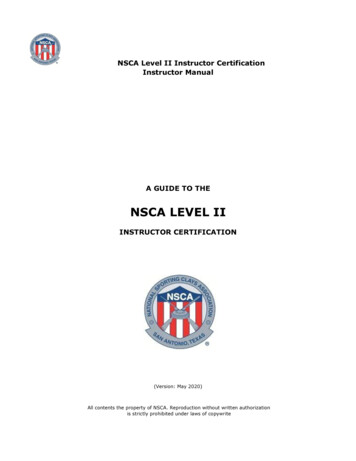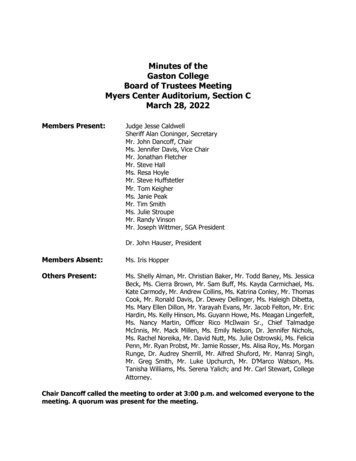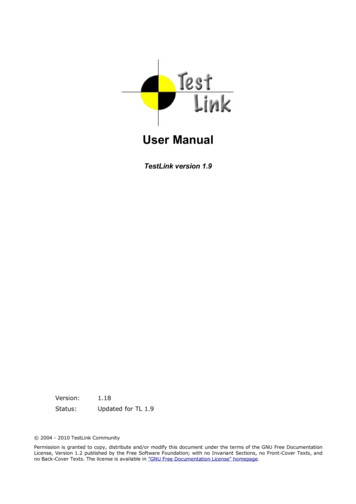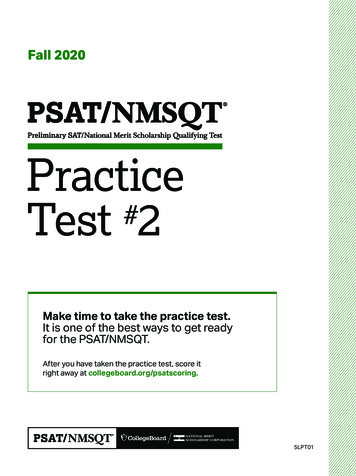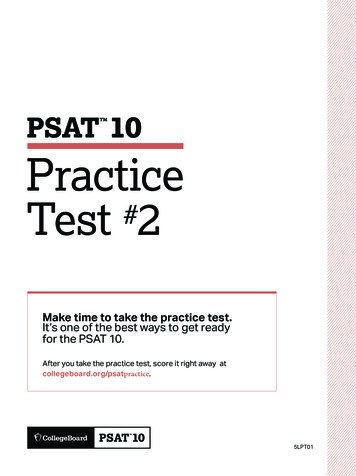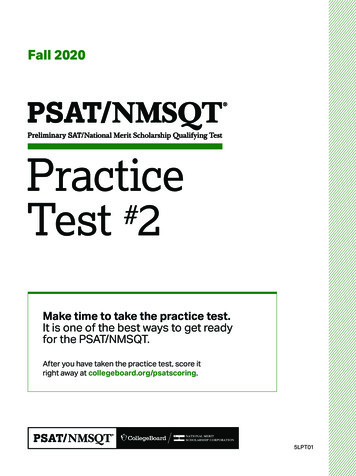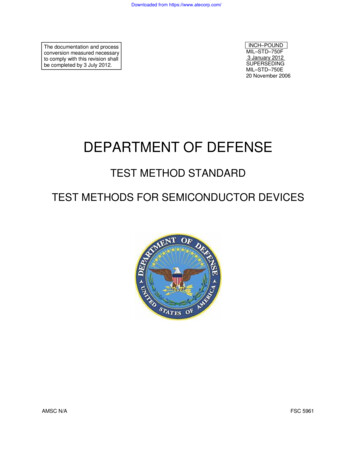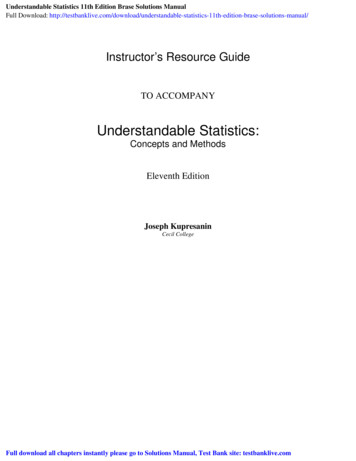
Transcription
Understandable Statistics 11th Edition Brase Solutions ManualFull Download: uctor’s Resource GuideTO ACCOMPANYUnderstandable Statistics:Concepts and MethodsEleventh EditionJoseph KupresaninCecil CollegeFull download all chapters instantly please go to Solutions Manual, Test Bank site: testbanklive.com
ISBN-13: 978-130510243-9ISBN-10: 1-30510243-6 2015 Cengage LearningALL RIGHTS RESERVED. No part of this work covered by thecopyright herein may be reproduced, transmitted, stored, orused in any form or by any means graphic, electronic, ormechanical, including but not limited to photocopying,recording, scanning, digitizing, taping, Web distribution,information networks, or information storage and retrievalsystems, except as permitted under Section 107 or 108 of the1976 United States Copyright Act, without the prior writtenpermission of the publisher except as may be permitted by thelicense terms below.For product information and technology assistance, contact us atCengage Learning Customer & Sales Support,1-800-354-9706.For permission to use material from this text or product, submitall requests online at www.cengage.com/permissionsFurther permissions questions can be emailed topermissionrequest@cengage.com.Cengage Learning200 First Stamford Place, 4th FloorStamford, CT 06902USACengage Learning is a leading provider of customizedlearning solutions with office locations around the globe,including Singapore, the United Kingdom, Australia,Mexico, Brazil, and Japan. Locate your local office at:www.cengage.com/global.Cengage Learning products are represented inCanada by Nelson Education, Ltd.To learn more about Cengage Learning Solutions,visit www.cengage.com.Purchase any of our products at your local collegestore or at our preferred online storewww.cengagebrain.com.NOTE: UNDER NO CIRCUMSTANCES MAY THIS MATERIAL OR ANY PORTION THEREOF BE SOLD, LICENSED, AUCTIONED,OR OTHERWISE REDISTRIBUTED EXCEPT AS MAY BE PERMITTED BY THE LICENSE TERMS HEREIN.READ IMPORTANT LICENSE INFORMATIONDear Professor or Other Supplement Recipient:Cengage Learning has provided you with this product (the“Supplement”) for your review and, to the extent that you adoptthe associated textbook for use in connection with your course(the “Course”), you and your students who purchase thetextbook may use the Supplement as described below. CengageLearning has established these use limitations in response toconcerns raised by authors, professors, and other usersregarding the pedagogical problems stemming from unlimiteddistribution of Supplements.Cengage Learning hereby grants you a nontransferable licenseto use the Supplement in connection with the Course, subject tothe following conditions. The Supplement is for your personal,noncommercial use only and may not be reproduced, postedelectronically or distributed, except that portions of theSupplement may be provided to your students IN PRINT FORMONLY in connection with your instruction of the Course, so longas such students are advised that theyPrinted in the United States of America1 2 3 4 5 6 7 17 16 15 14 13may not copy or distribute any portion of the Supplement to anythird party. You may not sell, license, auction, or otherwiseredistribute the Supplement in any form. We ask that you takereasonable steps to protect the Supplement from unauthorizeduse, reproduction, or distribution. Your use of the Supplementindicates your acceptance of the conditions set forth in thisAgreement. If you do not accept these conditions, you mustreturn the Supplement unused within 30 days of receipt.All rights (including without limitation, copyrights, patents, andtrade secrets) in the Supplement are and will remain the sole andexclusive property of Cengage Learning and/or its licensors. TheSupplement is furnished by Cengage Learning on an “as is” basiswithout any warranties, express or implied. This Agreement willbe governed by and construed pursuant to the laws of the Stateof New York, without regard to such State’s conflict of law rules.Thank you for your assistance in helping to safeguard the integrityof the content contained in this Supplement. We trust you find theSupplement a useful teaching tool.
Table of ContentsPART I: COURSE OVERVIEW AND TEACHING TIPS2PART II: FREQUENTLY USED FORMULAS AND TRANSPARENCY MASTERS23PART III: SAMPLE CHAPTER TESTS AND ANSWERS62PART IV: COMPLETE SOLUTIONS207
Part ICourse Overview and Teaching Tips
Suggestions for Using the TextIn writing this text, we have followed the premise that a good textbook must be more than just a repository ofknowledge. A good textbook should be an agent that interacts with the student to create a working knowledge of thesubject. To help achieve this interaction, we have modified the traditional format in order to encourage activestudent participation.Each chapter begins with Preview Questions, which indicate the topics addressed in each section of the chapter.Next is a Focus Problem that uses real-world data. The Focus Problems show the students the kinds of questionsthey can answer once they have mastered the material in the chapter. Consequently, students are asked to solve eachchapter’s Focus Problem as soon as the concepts required for the solution have been introduced.Procedure displays, which summarize key strategies for carrying out statistical procedures and methods, anddefinition boxes are interspersed throughout each chapter. Another special feature of this text is the GuidedExercises built into the reading material. These Guided Exercises, which include complete worked solutions, helpthe students to focus on key concepts in the newly introduced material. Also, the Section Problems reinforce studentunderstanding and sometimes require the student to look at the concepts from a slightly different perspective thanthe one presented in the section. Some Section Problems are categorized as Statistical Literacy, Critical Thinking,Basic Computation, or Expand Your Knowledge. The Statistical Literacy problems typically review definitions andstatistical symbols used in the text. Critical Thinking problems often ask about statistical formulas and unusualsituations that involve common ideas. Basic Computation problems are just that – problems designed to reinforcethe raw mechanics of statistical formulas or procedures. Expand Your Knowledge problems appear at the end ofeach section and present enrichment topics designed to challenge the student with the most advanced concepts inthat section.The Chapter Review Problems are much more comprehensive. They require students to place each problem in thecontext of all they have learned in the chapter. Data Highlights, found at the end of each chapter, ask students tolook at data as presented in newspapers, magazines, and other media and then to apply relevant methods ofinterpretation. Finally, Linking Concept problems ask students to verbalize their skills and synthesize the material.We believe that the progression from small-step Guided Exercises to Section Problems, Chapter Review Problems,Data Highlights, and Linking Concepts will enable instructors to use their class time in a very profitable way, goingfrom specific mastery details to more comprehensive decision-making analysis.Calculators and statistical computer software remove much of the computational burden from statistics. Many basicscientific calculators provide the mean and standard deviation. Calculators that support two-variable statisticsprovide the coefficients of the least-squares line, the value of the correlation coefficient, and the predicted value of yfor a given x. Graphing calculators sort the data, and many provide the least-squares line. Statistical softwarepackages give full support for descriptive statistics and inferential statistics. Students benefit from using thesetechnologies. In many examples and exercises in Understandable Statistics we ask students to use calculators toverify answers. For example, in keeping with the use of computer technology and standard practice in research,hypothesis testing is now introduced using P values. The critical region method is still supported but is not givenprimary emphasis. Illustrations in the text show TI-83Plus/TI-84Plus, MINITAB, SPSS, and Microsoft Exceloutputs, so students can see the different types of information available to them through the use of technology.However, it is not enough to enter data and punch a few buttons to get statistical results. The formulas that producethe statistics contain a great deal of information about the meaning of those statistics. The text breaks down formulasinto tabular form so that students can see the information in the formula. We find it useful to take class time todiscuss formulas. For instance, an essential part of the standard deviation formula is the comparison of each datavalue with the mean. When we point this out to students, it gives meaning to the standard deviation. When studentsunderstand the content of the formulas, the numbers they get from their calculators or computers begin to makesense.3
The eleventh edition includes Cumulative Reviews at the end of chapters 3, 6, 9, and 11; these sections tie togetherthe concepts from those chapters to help the student to put those concepts in a larger context. The Technology Notesbriefly describe relevant procedures for using the TI-83Plus/TI-84Plus calculator, Microsoft Excel, MINITAB, andSPSS. In addition, the Using Technology sections have been updated to include SPSS material.For a course in which technologies are strongly incorporated into the curriculum, we provide Technology Guides(for TI-83Plus/TI-84Plus, MINITAB, Microsoft Excel, and SPSS). These guides gives specific hints for using thetechnologies and also provide Lab Activities to help students explore various statistical concepts.Finally, accompanying the text are several interactive components that help to demonstrate key concepts. Throughon-line tutorials and an interactive textbook, the student can manipulate data to see and understand the effects incontext.4
Alternate Paths through the TextAs with previous editions, the eleventh edition of Understandable Statistics is designed to be flexible. In most onesemester courses, it is not possible to cover all the topics. The text provides many topics, so you can tailor a courseto fit student needs. The text also aims to be a readable reference for topics not specifically included in your course.Table of Prerequisite MaterialChapterPrerequisite Sections1 Getting StartedNone2 Organizing Data1.1, 1.23 Averages and Variation1.1, 1.2, 2.24 Elementary Probability Theory1.1, 1.2, 2.2, 3.1, 3.25 The Binomial Probability Distributionand Related Topics1.1, 1.2, 2.2, 3.1, 3.2, 4.1, 4.2, with 4.3 useful but not essential6 Normal Curves and SamplingDistributionsWith 6.6 omittedWith 6.6 included1.1, 1.2, 2.2, 3.1, 3.2, 4.1, 4.2, 5.1Add 5.2, 5.37 EstimationWith 7.3 and parts of 7.4 omittedWith 7.3 and all of 7.41.1, 1.2, 2.2, 3.1, 3.2, 4.1, 4.2, 5.1, 6.1, 6.2, 6.3, 6.4, 6.5Add 5.2, 5.3, 6.68 Hypothesis TestingWith 8.3 and parts of 8.4 omittedWith 8.3 and all of 8.41.1, 1.2, 2.2, 3.1, 3.2, 4.1, 4.2, 5.1, 6.1, 6.2, 6.3, 6.4, 6.5Add 5.2, 5.3, 6.69 Correlation and Regression9.1 and 9.29.3 and 9.41.1, 1.2, 3.1, 3.2Add 4.1, 4.2, 5.1, 6.1, 6.2, 6.3, 6.4, 6.5, 7.1, 8.1, 8.210 Chi-Square and F DistributionsWith 10.3 omittedWith 10.3 included1.1, 1.2, 2.2, 3.1, 3.2, 4.1, 4.2, 5.1, 6.1, 6.2, 6.3, 6.4, 6.5, 8.1Add 7.111 Nonparametric Statistics1.1, 1.2, 2.2, 3.1, 3.2, 4.1, 4.2, 5.1, 6.1, 6.2, 6.3, 6.4, 6.5, 8.1, 8.35
Teaching Tips for Each ChapterCHAPTER 1: GETTING STARTEDDouble-Blind Studies (Section 1.3)The double-blind method of data collection, mentioned at the end of Section 1.3, is an important part of standardresearch practice. A typical use is in testing new medications. Because the researcher does not know which patientsare receiving the experimental drug and which are receiving the established drug (or a placebo), the researcher isprevented from doing things subconsciously that might skew the results.If, for instance, the researcher communicates a more optimistic attitude to patients in the experimental group, thiscould influence how they respond to diagnostic questions or actually might influence the course of their illness. Andif the researcher wants the new drug to prove effective, this could subconsciously influence how he or she handlesinformation related to each patient’s case. All such factors are eliminated in double-blind testing.The following appears in the physician’s dosing instructions package insert for the prescription drug QUIXIN :In randomized, double-masked, multicenter controlled clinical trials where patients were dosed for5 days, QUIXIN demonstrated clinical cures in 79% of patients treated for bacterialconjunctivitis on the final study visit day (days 6–10).Note the phrase double-masked. Apparently, this is a synonym for double-blind. Since double-blind is used widelyin the medical literature and in clinical trials, why do you suppose that the company chose to use double-maskedinstead?Perhaps this will provide some insight: QUIXIN is a topical antibacterial solution for the treatment ofconjunctivitis; i.e., it is an antibacterial eye drop solution used to treat an inflammation of the conjunctiva, themucous membrane that lines the inner surface of the eyelid and the exposed surface of the eyeball. Perhaps, sinceQUIXIN is a treatment for eye problems, the manufacturer decided the word blind should not appear anywhere inthe discussion.Source: Package insert. QUIXIN is manufactured by Santen Oy, P.O. Box 33, FIN-33721 Tampere, Finland, andmarketed by Santen, Inc., Napa, CA 94558, under license from Daiichi Pharmaceutical Co., Ltd., Tokyo, Japan.CHAPTER 2: ORGANIZING DATAEmphasize when to use the various graphs discussed in this chapter: bar graphs when comparing data sets, circlegraphs for displaying how data are dispersed into several categories, time-series graphs to display how data changeover time, histograms or frequency polygons to display relative frequencies of grouped data, and stem-and-leafdisplays for displaying grouped data in a way that does not lose the detail of the original raw data.Drawing and Using Ogives (Section 2.1)The text describes how an ogive, which is a graph displaying a cumulative-frequency distribution, can beconstructed easily using a frequency table. However, a graph of the same basic sort can be constructed even morequickly than that. Simply arrange the data values in ascending order and then plot one point for each data value,where the x coordinate is the data value and the y coordinate starts at 1 for the first point and increases by 1 for eachsuccessive point. Finally, connect adjacent points with line segments. In the resulting graph, for any x, thecorresponding y value will be (roughly) the number of data values less than or equal to x.For example, here is the graph for the data set 64, 65, 68, 73, 74, 76, 81, 84, 85, 88, 92, 95, 95, and 99:6
This graph is not technically an ogive because the possibility of duplicate data values (such as 95 in this example)means that the graph will not necessarily be a function. But the graph can be used to get a quick fix on the generalshape of the cumulative distribution curve. And by implication, the graph can be used to get a quick idea of theshape of the frequency distribution, as illustrated below.Psuedo - Ogive Uniform DistributionUniform 20.480.640.800.960.01.120.20.40.60.81.0Psuedo - Ogive Normal DistributionNormal e pseudo-ogive obtained from the example data set suggests a uniform distribution on the interval 63–100 orthereabouts.CHAPTER 3: AVERAGES AND VARIATIONStudents should be instructed in the various ways that sets of numeric data can be represented by a single number.The concepts of this section illustrate for students the need for this kind of representation.7
The different ways this can be done are discussed in Section 3.1. The mean, median, and mode vary inappropriateness depending on the situation. In many cases of numeric data, the mean is the most appropriatemeasure of central tendency. If the mean is larger or smaller than most of the data values, however, then the medianmay be the number that best represents the data set. The median is most appropriate usually if the data set is annualsalaries, costs of houses, or any data set that contains one or a few very large or very small values. The mode wouldbe most appropriate if the population were the votes in an election or Nielsen television ratings, for example.Students should get acquainted with these concepts by calculating the mean, median, and mode for different datasets and then interpreting the meaning of each one and determining which measure of central tendency is the mostappropriate.The range, variance, and standard deviation can be presented to students as other numbers that aid in therepresentation of a data set in that they measure how data are dispersed. Students will begin to have a betterunderstanding of these measures of dispersion by calculating these numbers for given data sets and interpreting theirrespective meanings. These concepts of central tendency and dispersion also can be applied to grouped data, andstudents should become acquainted with interpreting these measures for given realistic situations in which data havebeen collected.Chebyshev’s theorem is important to discuss with students because it relates to the mean and standard deviation ofany data set.Finally, the mean, median, first and third quartiles, and range of a data set can be viewed easily in a box-andwhisker plot.CHAPTER 4: ELEMENTARY PROBABILITY THEORYWhat Is Probability? (Section 4.1)As the text describes, there are several methods for assigning a probability to an event. Probability based on intuitionis often called subjective probability. Thus understood, probability is a numerical measure of a person’s estimate ofthe likelihood of some event. Subjective probability is assumed to be reflected in a person’s decisions: The higher anevent’s probability, the more the person would be willing to bet on its occurring.Probability based on relative frequency is often called experimental probability because the relative frequency iscalculated from an observed history of experiment outcomes. But we are already using the word experiment in a waythat is neutral among the different treatments of probability—namely, as the name for the activity that producesvarious possible outcomes. So when we are talking about probability based on relative frequency, we will call thisobserved probability.Probability based on equally likely outcomes is often called theoretical probability because it is ultimately derivedfrom a theoretical model of the experiment’s structure. The experiment may be conducted only once, or not at all,and need not be repeatable.These three ways of treating probability are compatible and complementary. For a reasonable, well-informed person,the subjective probability of an event should match the theoretical probability, and the theoretical probability, inturn, predicts the observed probability as the experiment is repeated many times.Also, it should be noted that although in statistics probability is officially a property of events, it can be thought of asa property of statements as well. The probability of a statement equals the probability of the event that makes thestatement true.Probability and statistics are overlapping fields of study; if they weren’t, there would be no need for a chapter onprobability in a book on statistics. So the general statement in the text that probability deals with known populations,whereas statistics deals with unknown populations is necessarily a simplification. However, the statement doesexpress an important truth: If we confront an experiment we initially know absolutely nothing about, then we cancollect data but we cannot calculate probabilities. In other words, we can only calculate probabilities after we have8
formed some idea of, or acquaintance with, the experiment. To find the theoretical probability of an event, we haveto know how the experiment is set up. To find the observed probability, we have to have a record of previousoutcomes. And as reasonable people, we need some combination of those same two kinds of information to set oursubjective probability.This may seem obvious, but it has important implications for how we understand technical concepts encounteredlater in the course. There will be times when we would like to make a statement, say, about the mean of a populationand then give the probability that this statement is true—i.e., the probability that the event described by thestatement occurs (or has occurred). What we discover when we look closely, however, is that often this cannot bedone. Often we have to settle for some other conclusion instead. The Teaching Tips for Sections 7.1 and 8.1 describetwo instances of this problem.CHAPTER 5: THE BINOMIAL PROBABILITY DISTRIBUTION AND RELATEDTOPICSBinomial Probabilities (Section 5.2)Students should be able to show that pq p(1 – p) has its maximum value at p 0.5. There are at least three ways todemonstrate this: graphically, algebraically, and using calculus.Graphical methodRecall that 0 p 1. So, for q 1 – p, 0 q 1 and 0 pq 1. Plot y pq p(1 – p) using MINITAB, a graphingcalculator, or other technology. The graph is a parabola. Observe which value of p maximizes pq. (Many graphingcalculators can find the maximum value and where it occurs.)So pq has a maximum value of 0.25 when p 0.5.Algebraic methodFrom the definition of q, it follows that pq p(1 – p) p – p2 –p2 p 0. Recognize that this is a quadraticfunction of the form ax2 bx c, where p is used instead of x, and a –1, b 1, and c 0.The graph of a quadratic function is a parabola, and the general form of a parabola is y a(x – h)2 k. The parabolaopens up if a 0 and opens down if a 0 and has a vertex at (h, k). If the parabola opens up, it has its minimum at x h, and the minimum value of the function is y k. Similarly, if the parabola opens down, it has its maximum valueof y k, when x h.Using the method of completing the square, we can rewrite y ax2 bx c in the form y a(x – h)2 k to show thatbb2and k c . When a –1, b 1, and c 0, it follows that h 1/2 and k 1/4. So the value of p that2a4amaximizes pq is p 1/2, and then pq 1/4. This confirms the results of the graphical solution.h Calculus-based methodAdvanced Placement students probably have had (or are taking) calculus, including tests for local extrema. For afunction with continuous first and second derivatives, at an extremum, the first derivative equals 0, and the secondderivative is either positive (at a minimum) or negative (at a maximum).9
The first derivative of f(p) pq p(1 p) is given byd f ′( p )[ p (1 p )]dpd [ p 2 p]dp 2 p 1Solve f ′( p ) 0: 2 p 1 0p 12 1 Now find f ′′ : 2 df ′′( p ) [ f ′( p )]dpd ( 2 p 1)dp 2 1 So f ′′ 2. 2 1Since the second derivative is negative when the first derivative equals 0, f(p) has a maximum at p .2This result has implications for confidence intervals for p; see the Teaching Tips for Chapter 7.CHAPTER 6: NORMAL CURVES AND SAMPLING DISTRIBUTIONSEmphasize the differences between discrete and continuous random variables with examples of each.Emphasize how normal curves can be used to approximate the probabilities of both continuous and discrete randomvariables, and in the cases when the distribution of a data set can be approximated by a normal curve, such a curve isdefined by two quantities: the mean and standard deviation of the data. In such a case, the normal curve is definedby this equation:( )x µ 2y e 1 σ2σ 2πReview Chebyshev’s theorem from Chapter 3. Emphasize that this theorem implies that for any data set,at least 75% of the data lie within 2 standard deviations on each side of the mean, at least 88.9% of the data liewithin 3 standard deviations on each side of the mean, and at least 93.75% of the data lie within 4 standarddeviations on each side of the mean.In comparison, a data set that has a distribution that is symmetric and bell-shaped, or in particular, an approximatenormal distribution, is more restrictive in that1.2.3.Approximately 68% of the data values lie within 1 standard deviation on each side of the mean,Approximately 95% of the data values lie within 2 standard deviations on each side of the mean, andApproximately 99.7% of the data values lie within 3 standard deviations on each side of the mean.Remind students regularly that a z value equals the number of standard deviations from the mean for data values ofany distribution approximated by a normal curve.10
Emphasize the connection between the area under a normal curve and probability values of the random variable.That is, emphasize that the area under any normal curve equals 1 and that the percentage of area under the curvebetween given values of the random variable equals the probability that the random variable will be between thesevalues. The values in a z table are areas and probability values.Emphasize the differences between population parameters and sample statistics. Point out that when knowledge ofthe population is unavailable, then knowledge of a corresponding sample statistic must be used to make inferencesabout the population.Emphasize the main two facts derived from the central limit theorem:1.If x is a random variable with a normal distribution whose mean is μ and standard deviation is σ, then themeans of random samples for any fixed-size n taken from the x distribution is a random variable x that hasa normal distribution with mean μ and standard deviation σ n .2.If x is a random variable with any distribution whose mean is μ and standard deviation is σ, then the meanof random samples of a fixed-size n taken from the x distribution is a random variable x that has adistribution that approaches a normal distribution with mean μ and standard deviation σ n as n increaseswithout limit.Choosing sample sizes greater than 30 is an important point to emphasize in the situation mentioned in part 2 of thecentral limit theorem above. This commonly accepted convention ensures that the x distribution of part 2 will havean approximate normal distribution regardless of the distribution of the population from which these samples aredrawn.Emphasize that the central limit theorem allows us to infer facts about populations from sample means havingnormal distributions.Emphasize the conditions whereby a binomial probability distribution (discussed in Chapter 5) can be approximatedby a normal distribution: np 5 and n(1 – p) 5, where n is the number of trials and p is the probability of successin a single trial.When a normal distribution is used to approximate a discrete random variable (such as the random variable of abinomial probability experiment), the continuity correction is an important concept to emphasize to students. Adiscussion of this important adjustment can be a good opportunity to compare discrete and continuous randomvariables.Emphasize that facts about sampling distributions for proportions relating to binomial experiments can be inferred ifthe same conditions satisfied by a binomial experiment that can be approximated by a normal distribution aresatisfied: np 5 and n(1 – p) 5, where n is the number of trials and p is the probability of success in a single trial.Emphasize the difference in the continuity correction that must be taken into account in the sampling distribution forproportions and the continuity correction for a normal distribution used to approximate the probability distributionof the discrete random variable in a binomial probability experiment. That is, instead of subtracting 0.5 from the leftendpoint and adding 0.5 to the right endpoint of an interval involved in a normal distribution approximating abinomial probability distribution, 0.5/n must be subtracted from the left endpoint and 0.5/n must be added to theright endpoint of such an interval when a normal distribution is used to approximate a sampling distribution forproportions.CHAPTER 7: ESTIMATIONAs the text says, nontrivial probability statements involve variables, not constants. And if the mean of a populationis considered a constant, then the event that this mean falls in a certain range with known numerical bounds haseither probability 1 or probability 0.11
However, we might instead think of the population mean as itself a variable because, after all, the value of the meanis unknown initially. In other words, we may think of the population from which we are sampling as one of manypopulations—a population of populations, if you like. One of these populations has been randomly selected for us towork with, and we are trying to figure out which population it is or at least what its mean is.If we think of our sampling activity in this way, we can then think of the event “The mean lies between a and b” ashaving a nontrivial probability of being true. Can we now create a 90% confidence interval and then say that themean has a 90% probability of being in that interval? It might seem so, but in general, the answer is no. Even thougha procedure might have exactly a 90% success rate at creating confidence intervals that contain the mean, aconfidence interval created by such a procedure will not, in general, have exactly a 90% chance of containing themean.How is this possible? To understand this paradox, let us turn from mean finding to a simpler task: guessing the colorof a randomly drawn marble. Suppose that a sack contains some red marbles and some blue marbles. And supposethat we have a friend wh
Calculators and statistical computer software remove much of the computational burden from statistics. Many basic scientific calculators provide the mean and standard deviation. Calculators that support two-variable statistics provide the coefficients of the least-squares line, the value of the correlation coefficient, and the predicted value of
